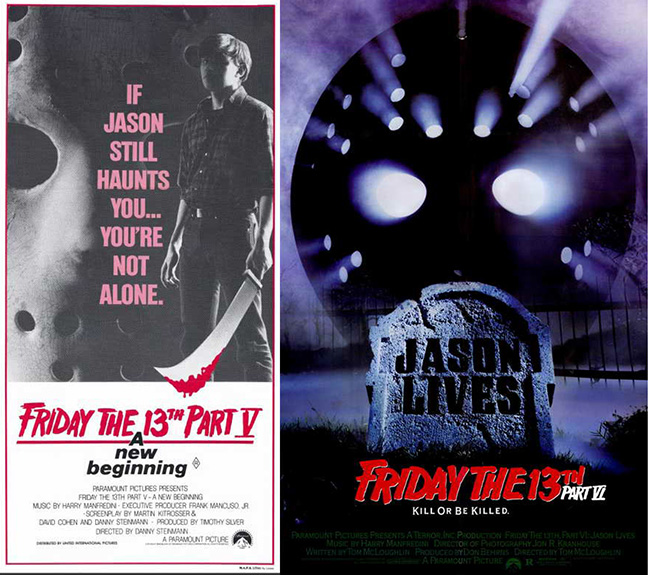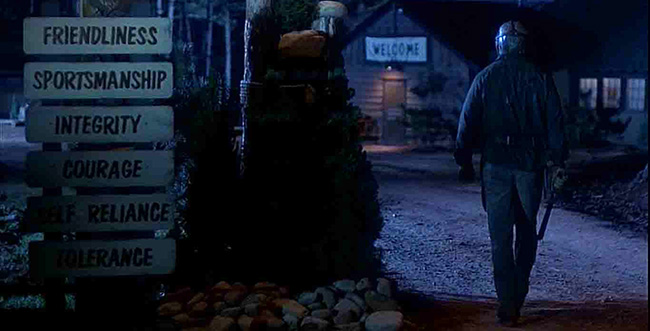
Only a year after the “final” installment in the Jason Voorhees saga, Paramount unleashed Friday the 13th: A New Beginning (1985) – because there were bills to pay. The studio made a two-picture deal with director Danny Steinmann (Savage Streets), the other project being a never-made sequel to Last House on the Left. Steinmann proved a controversial choice, though before his death in 2012 he dismissed accusations that it was a troubled production. Regardless, one thing is certain: he was determined to amplify the sex and violence. The former hardcore porn director ensures that many of the women get naked; reportedly one actress was rejected for the role of Tina because her breasts weren’t large enough, with the perfectly named Debi Sue Voorhees (Avenging Angel), a Playboy Playmate, stepping into the role (memorably) instead. In a 2009 interview with Jeff Cramer, Steinmann said he was given “orders” as part of accepting the job. “I was to deliver a shock, scare, or kill every seven or eight minutes.” This certainly explains the messy structure of the film, which is constantly introducing new characters only to kill them a short while later. When making notes for these reviews, I try to keep track of character names. My notes here look like a roll call: Tommy Jarvis and Pat and Matthew and Ethel and Junior and Vic and Joey and Robin and Eddie and Tina and Lana and Billy and Roy and Jake and Pete and Reggie the Reckless…
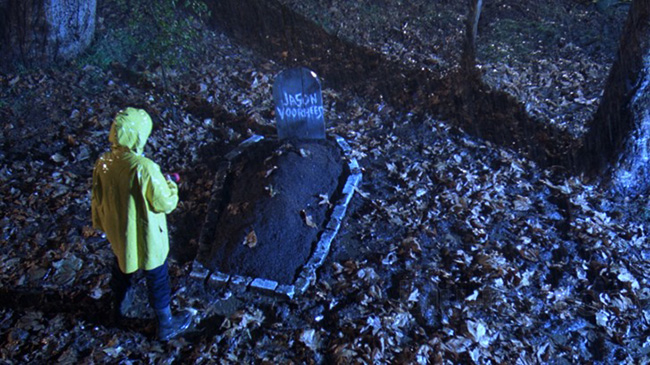
Corey Feldman reprises his role as young Tommy Jarvis in the prologue.
Many Friday the 13th fans consider A New Beginning the worst in the series, though its reputation has improved somewhat in recent years. The film begins promisingly, with Corey Feldman returning to his Friday the 13th: The Final Chapter (1984) role of 12-year-old Tommy Jarvis, visiting the grave of Jason Voorhees on a stormy night. An earthworm-slathered Jason rises from the grave to kill, but it’s all just the nightmare of a much older Tommy, now played by John Shepherd. (Even though time has advanced significantly, it’s quite clearly 1985-ish.) Tommy, who still makes monster masks as a hobby, is being transported from a rigid mental institution to the more laid-back Pinehurst Youth Development Center, where troubled teenagers are rehabilitated in a forested setting. Here A New Beginning quickly settles into formula, with a large cast of broad stereotypes offed one by one by Jason. The two most egregious characters, Ethel (Carol Locatell, Coffy) and her Randy Quaid-like son Junior, are abrasive hillbillies who clash with Pinehurst because the teens are having sex in the woods near their property. “I want this loony bin closed down!” Ethel shrieks. The comedy could charitably be called high camp; or, uncharitably, just lousy. To its credit, the screenplay is self-aware, although with this being the fifth Friday the 13th film, it’s hard not to be: one doomed greaser says, “As far as I’m concerned, all those loonies can get killed off one by one.” (He’s right! They will be!) The comedy almost works better when it pushes itself into the realm of the bizarre, such as two weird moments that threaten to turn the film into a musical. One of the greasers improvises a hyper, coke-addled song while trying to start his car. Another guy has a duet with his girlfriend through the wall of an outhouse, both acting as though even they don’t know why this scene was written. But the most out-of-nowhere moment comes early on, when musclehead Vic (Mark Venturini) decides to take a break from chopping wood to bury his axe in the body of the chocolate-smeared token fat kid, Joey (Dominick Brascia, Evil Laugh), presumably because we all know Jason was going to kill him anyway, and director Steinmann had a kill rate to maintain. (When the paramedics arrived to cart Joey’s body away, my wife said, “Wait? That really happened?” She was waiting for it to be revealed as just another dream.) Turns out this crazed moment has a purpose for the plot – yes, there is one.
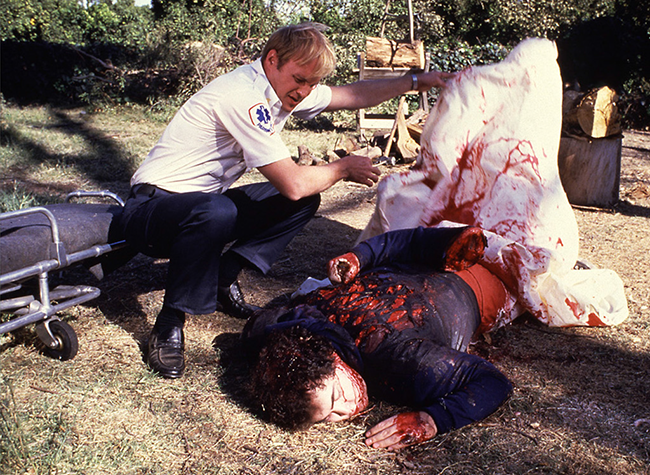
Joey (Dominick Brascia) is slaughtered, but not by Jason.
A spoiler warning, as though it really matters…although much of the film is a misdirect that “Jason” might actually be Tommy Jarvis in disguise, in fact the killer is Joey’s father Roy. When the two masks are both pulled off Scooby-Doo style to reveal the dead Roy, the audience will probably just say, “Wait, who?” A New Beginning has so many characters that we can barely keep them straight, and this guy had the least screen time of any of them. So – as with the first Friday film – Jason is not the true villain of the picture. Why this should outrage so many fans is a bit beyond me…not only does is its twist a nod to the first film (which also lacked a Jason), but who cares who’s been behind the mask? You still get a hockey mask-wearing killer stalking teenagers. Potato/potahto. The final reveal is both silly and atrocious, but it’s also inconsequential to how the film works (or doesn’t work) as a slasher movie. Steinmann’s other order from on high was to make sure that Tommy Jarvis complete a transformation into Jason, and this becomes the film’s coda, as Tommy, in a hospital, removes the Jason mask from his drawer and pulls a machete on Final Girl Pam (Melanie Kinnaman). To the film’s credit, it does continue Tommy’s story from Part IV in a somewhat logical way; as you’ll recall, that film ended with adolescent Tommy shaving his head and demonstrating the warning signs of a future sociopath as he stabbed Jason over and over. The film made money and was #1 in its opening weekend (for the record, this underage author was over in another theater watching the now-forgotten Baby: Secret of the Lost Legend, because dinosaurs). Yet reviews were even terrible by Friday the 13th standards, and Steinmann was not invited back. If many fans have come around to the film over the years, it has a lot to do with the go-for-broke exploitation vibe. Steinmann shot a lowbrow movie ready-made for the grindhouse, not the multiplex.
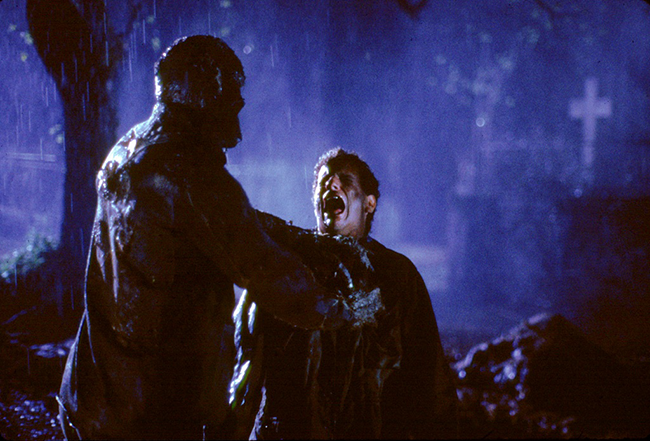
In the prologue of “Jason Lives,” Jason once again rises from the grave – but this time it’s not a dream.
A New Beginning performed well enough that Paramount didn’t hesitate to get another production in place for 1986. Tom McLoughlin (One Dark Night) wrote and directed Jason Lives: Friday the 13th Part VI; the title made it perfectly clear to fans that this would be a return to form, with Jason back behind the mask. Tommy Jarvis also returns, but not only is he played by a different actor, the third to take the role (Thom Mathews, The Return of the Living Dead), but the events of Steinmann’s epilogue are completely ignored: Tommy hasn’t been possessed by Jason, he’s just determined to put a stop to him. The prologue here echoes that of A New Beginning, with Tommy visiting Jason’s grave on a stormy night, but Jason’s resurrection is not a dream. His rise has Frankenstein proportions, with lightning striking a metal post jammed in his chest. Later in the film a rock song will also reference Frankenstein, perhaps signaling that McLoughlin was more interested in making an old-fashioned monster movie than a slasher. McLoughlin’s film may not be particularly memorable, but it’s better than its predecessor, slicker, wittier, with better developed characters and a stronger, more elaborate climax. He also dials back on the elements which angered so many critics (notably Roger Ebert); his film is much less exploitative than its forebears, with just a little sex and no nudity. Even the sex scene has a sense of humor, with the girl insisting they keep going until the rock song is finished playing. “How much longer?” the boy asks. “It’s only ten more minutes,” she says, and he gives a look of mild alarm. McLoughlin even gives Jason his own James Bond-spoofing introduction, striding in front of the camera and throwing a knife at the audience to unleash the bloody opening titles. Granted, sometimes the humor can be a bit too self-conscious: a caretaker – there’s always one – fills Jason’s empty grave while grumbling, “Why’d they have to go dig up Jason?” before he looks directly into the camera and says, “Some folks got a strange idea of entertainment.” (Breaking the fourth wall is not the way to top Friday the 13th’s foray into 3-D.) But this movie contains the most sublime moment of the entire series. Jason enters a cabin filled with sleeping children. He hears a whimper, and sees that one little girl is awake. He leans over her, his mask almost up against her face, and she closes her eyes and prays. Then he hears car doors slamming outside – the police have arrived – and he’s gone when she opens her eyes. So she checks under the bed.
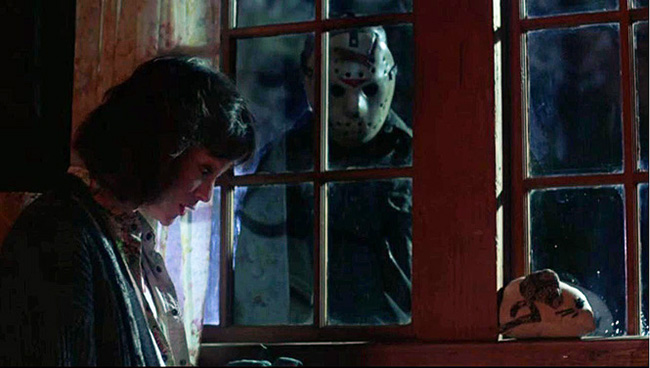
Jason stalks again in “Jason Lives.”
Most importantly, McLoughlin stages suspense scenes, not just “kills.” Camp leaders Lizbeth (the director’s wife, Nancy McLoughlin) and Darren (Tony Goldwyn of Ghost), driving at night toward Crystal Lake (now renamed by the locals to Forest Green) encounter Jason on the road. They don’t get out of the car. Lizbeth says, “I’ve seen enough horror movies to know any weirdo wearing a mask is never friendly.” But if they reverse, the car will get stuck. No decision – forward, reverse, or out the car doors – is a good one, and Jason waits to see what they’ll do, impassive as ever. In later sequences – Jason stalking teenagers driving at high speed in a trailer, a sheriff blasting Jason over and over with a shotgun to no avail, a final showdown on the lake – McLoughlin demonstrates an understanding of what makes a good Friday the 13th entry outside the sex-and-gore parameters. And it’s hard to dislike a film in which a small child is reading Jean-Paul Sartre’s No Exit. Apart from the apropos title, Sartre’s book demonstrated that hell is other people. That was true for Part V, but in Part VI McLoughlin wanted to provide better company. His Tommy Jarvis is much easier to spend time with, and his flirtatious team-up with the sheriff’s cute daughter, Megan (Jennifer Cooke, V), at least makes the film a more enjoyable watch. Is this the best Friday the 13th? Probably not, but in trying to distance itself from the silly, brain-dead excesses of A New Beginning, it manages to provide a welcome dose of thrills and imagination. Not that you’ll remember much of it a day later; such are the problems of going through these motions for the sixth time around.
